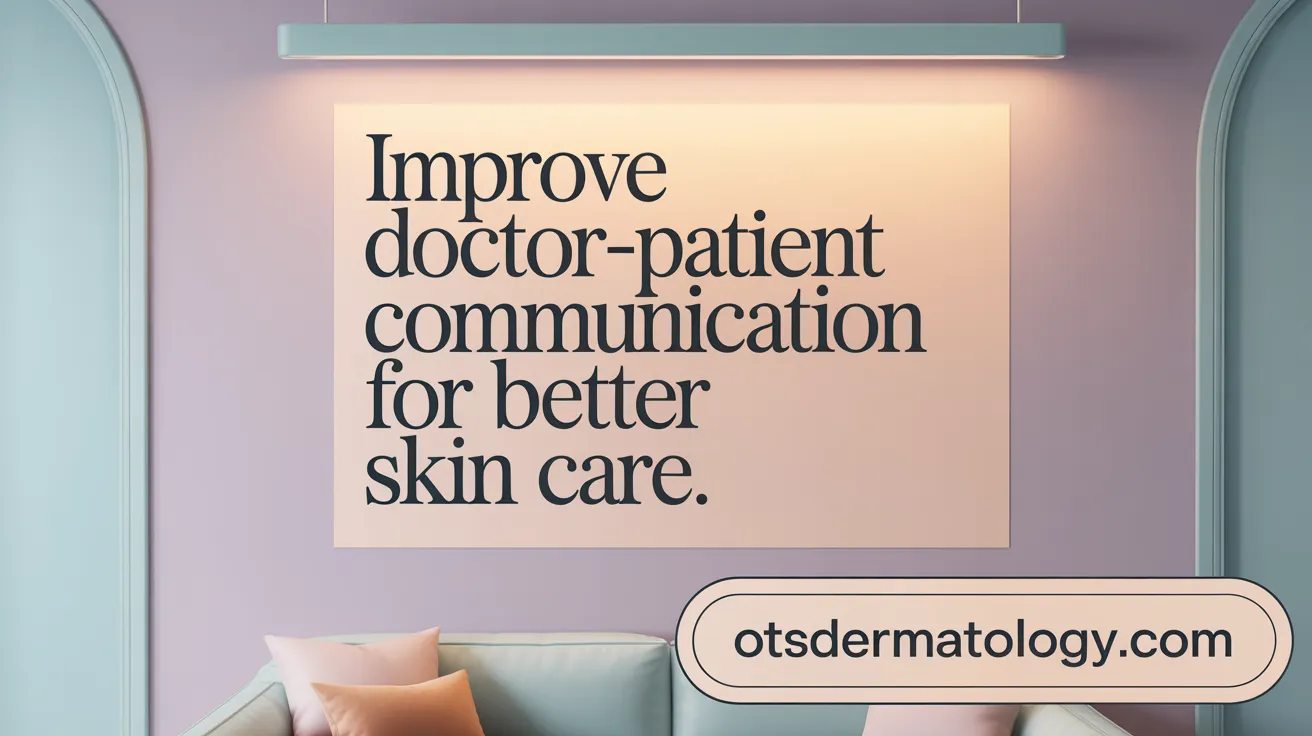Understanding Patient-Centered Dermatology
In an evolving healthcare landscape, dermatology care is shifting towards patient-centered models that prioritize individual needs, preferences, and active patient engagement. Doing so enhances treatment effectiveness, satisfaction, and overall skin health outcomes. This article explores how patients can prepare effectively for dermatology visits, what to expect during consultations, and how patient-centered approaches improve communication, care planning, and clinical environments to make dermatology visits more productive and empowering.
Preparing Effectively for Your Dermatology Appointment

How can patients effectively prepare for a dermatology appointment, including gathering relevant health information, organizing questions, and understanding necessary steps?
Proper preparation can significantly enhance the effectiveness of your dermatology visit. Start by compiling a detailed health and skin history. This includes noting past skin conditions, previous treatments, any allergies, current medications or supplements, and family history of skin issues such as skin cancer (Prepare for Your Dermatology Appointment, prepare history of eczema).
Gather relevant documentation such as biopsy results, lab work, or photographs of skin flare-ups or concerns. These visual aids can assist your dermatologist in evaluating your skin more accurately (Gathering health and skin history, Organize eczema photos).
Creating a list of specific questions or concerns before the appointment ensures you cover all necessary topics and don’t forget important details. Think about goals for your visit—whether it's managing a chronic condition, checking for suspicious moles, or discussing cosmetic options (Questions to ask your dermatologist, write down questions in advance).
Physical preparation also matters. Wear loose, comfortable clothing that is easy to remove, as this facilitates skin inspection. Avoid wearing makeup, foundation, tanning lotions, or lipstick on the day of your appointment, so the dermatologist can see your natural skin and identify potential issues clearly. Removing nail polish allows for examining the nails, which can reveal clues about your overall health (Wearing loose clothing for dermatology, Avoiding makeup and nail polish, Full-body skin examinations).
Understanding what the appointment will involve can help reduce anxiety. Expect a full-body skin examination, potentially including the use of a dermatoscope to examine moles or suspicious spots. Be ready to discuss your lifestyle, sun exposure, and skin care routines, and bring along all necessary documents (full body skin examination, Skin cancer early detection, Dermatology appointment preparation tips).
By taking these steps, you ensure your visit is thorough and productive, helping your dermatologist provide the most accurate diagnosis and effective treatment plan (Preparing for your first dermatology appointment, First dermatologist visit overview).
What to Expect During Your Dermatology Consultation

Full skin examination procedures
During a dermatology consultation, patients can anticipate a comprehensive examination of their skin, which typically involves a full-body skin check from head to toe. The dermatologist will inspect all skin surfaces, including less exposed areas such as the scalp, behind the ears, between the toes, and even under nails if necessary. To facilitate a detailed view, tools like dermatoscopes are often used to closely examine moles, suspicious spots, or skin lesions. Patients are usually advised to wear loose clothing and avoid applying makeup or nail polish on the day of the appointment to allow for an unobstructed assessment (Preparing for a dermatology appointment).
Common tests and biopsies
If the dermatologist detects any concerning areas, they may perform biopsies — where a small sample of skin is removed for laboratory analysis. This procedure helps confirm diagnoses such as skin cancer or other skin conditions (Preparing for Your First Dermatologist Visit). Additional tests, such as skin swabs, patch tests, or blood work, might also be ordered depending on the suspected issue. These diagnostic tools assist in identifying underlying causes and determining the most effective treatment plan (Dermatology consultation overview).
Discussion of diagnosis and treatment plans
Following the examination and any necessary testing, the dermatologist will discuss their findings with the patient. This includes explaining the diagnosis in accessible language (Effective communication in dermatology), outlining treatment options suitable for the condition—such as topical treatments, light or laser therapy, or minor surgical procedures—and answering any questions (Dermatology consultation overview, Dermatologists Communication Skills). The plan may involve medications, in-office procedures, or lifestyle recommendations, all tailored to the individual’s needs and circumstances. The dermatologist will also provide guidance on skincare routines, sun protection, and follow-up schedules (Building Loyalty through Patient Experience).
Follow-up and monitoring
Many skin conditions require ongoing monitoring to evaluate treatment effectiveness and adjust care plans as needed. Patients are often scheduled for follow-up visits to assess progress, perform additional biopsies if necessary, and ensure the skin’s health improves (Patient-Centered Online Care Model). For skin cancer screenings, regular examinations are advised annually or semi-annually, especially for those with increased risk factors (Annual skin cancer screening importance). Open communication between patients and dermatologists during these follow-ups helps in achieving optimal skin health and early detection of potential issues (doctor-patient relationship in dermatology).
Principles and Benefits of Patient-Centered Dermatology

What are the principles and benefits of patient-centered dermatology, including patient engagement, shared decision-making, and holistic care approaches?
Patient-centered dermatology emphasizes tailoring care to individual needs, preferences, and life circumstances. This approach recognizes that skin conditions can have profound physical, emotional, and social effects. A core principle involves active patient engagement, encouraging individuals to participate fully in their diagnosis and treatment planning.
Shared decision-making is fundamental; it involves open communication where dermatologists and patients collaborate to select therapies that align with patient values, daily routines, and treatment goals. This partnership fosters trust and ensures that treatment plans are realistic and acceptable.
Holistic management extends beyond physical symptoms, addressing psychological impacts such as anxiety or self-esteem issues and social concerns like stigma or social isolation. By considering these factors, dermatologists can better support overall well-being, as reflected in patient and caregiver perspectives and holistic healthcare approaches.
Incorporating patient-reported outcomes (PROs) enables clinicians to understand the real-world impact of skin conditions. PROs, including quality-of-life measures, help track treatment effectiveness from the patient's perspective and inform personalized care adjustments.
The benefits of this comprehensive, patient-focused approach include increased treatment adherence and higher satisfaction rates. Patients who actively participate in their care tend to be more committed to prescribed therapies, resulting in improved health outcomes.
Ultimately, adopting a patient-centered model nurtures a more empathetic healthcare environment, strengthening the doctor-patient relationship and supporting better overall dermatological care.
Enhancing Communication for Better Treatment Outcomes

How can communication between patients and dermatologists be improved to enhance understanding and treatment outcomes?
Effective communication forms the cornerstone of successful dermatological care. To foster better understanding, dermatologists should prioritize using clear, accessible language, avoiding complex medical jargon that might confuse patients. Visual aids such as diagrams, photos, and skin condition charts can significantly help patients grasp their diagnosis and see the progress of their treatments (Effective communication in dermatology).
Active listening and showing empathy are crucial. When providers listen attentively and respond respectfully, patients feel valued and are more comfortable expressing concerns or asking questions. This openness encourages adherence to treatment plans and improves overall satisfaction (doctor-patient relationship in dermatology).
Training programs based on validated tools like the Calgary-Cambridge Observation Guide help clinicians develop and refine their communication skills. Such programs focus on introduction, role explanation, and gathering comprehensive patient information, tailored to cultural and demographic factors (Dermatologists communication skills, Dermatologists Communication Skills).
Recognizing individual differences—such as age, education level, and cultural background—allows dermatologists to adapt their approach, making information more relatable and ensuring that care is patient-centered. Incorporating these strategies leads to improved understanding, stronger patient-provider relationships, and more effective treatment outcomes (Doctor–patient communication in dermatology).
Redesigning Dermatology Practice and Embracing Teledermatology

How can dermatology practice environments be redesigned around the patient to improve care delivery?
Transforming dermatology clinics into patient-centered spaces involves thoughtful design that prioritizes comfort, accessibility, and efficiency. This includes creating welcoming environments with clear signage, private areas for examinations, and ergonomic furniture that accommodates diverse patient needs, including seniors and individuals with disabilities. For more, see Rethink the Dermatology Room.
Facilities should incorporate privacy-enhancing features such as soundproof exam rooms and adjustable lighting. Mobile workstations can facilitate digital data access, ensuring seamless information flow without disrupting patient care. Proper storage, ergonomic cabinetry, and appropriate lighting contribute to a safe and comfortable setting.
Implementing universal design principles ensures accessibility for all, such as wheelchair-friendly entrances and adjustable treatment chairs. Staff training in disability sensitivity fosters a supportive atmosphere.
In addition to physical design, integrating onsite educational resources like brochures, digital screens, and interactive tools can boost patient engagement and understanding of skin health. Learn more about Creating the Optimal Patient Experience.
Teledermatology as a Complement to In-Person Care
Teledermatology, especially store-and-forward models, has gained prominence for managing chronic conditions like atopic dermatitis. Patients can submit images and health histories digitally, allowing dermatologists to assess and respond asynchronously. See the study on Patient-Centered Online Care Model for Atopic Dermatitis.
Research shows teledermatology provides diagnostic accuracy comparable to face-to-face consultations. Studies involving pediatric and adult patients with atopic dermatitis demonstrated that online follow-ups could achieve clinical outcomes similar to traditional visits.
This approach enhances access for underserved or remote populations, reduces appointment wait times, and supports continuous disease management. Regular feedback from patients helps refine telehealth services, ensuring they meet patient needs and improve satisfaction. For patient-centered research priorities in pediatric dermatology, see Pediatric Dermatology Research Alliance Patient Advisory Committee.
Continuous Improvement through Feedback
Gathering patient perspectives through surveys, informal conversations, and social media allows clinics to identify areas for improvement. Feedback on wait times, staff friendliness, and informational resources informs iterative changes. Resources on Gathering Patient Feedback provide strategies for this.
By embracing a holistic, patient-centered design—and leveraging telehealth solutions—dermatology practices can significantly enhance care quality, patient engagement, and overall satisfaction.
Search Query: Patient-centered dermatology clinic design and teledermatology
Empowering Patients Through Partnership in Dermatology Care
Adopting a patient-centered approach in dermatology transforms visits from routine examinations into meaningful partnerships focused on individual well-being. By preparing thoughtfully, understanding what to expect, engaging actively with providers, and benefiting from innovations in communication and care delivery, patients can optimize their dermatological healthcare experience. This collaborative model not only improves clinical outcomes but fosters trust, satisfaction, and empowerment, ensuring skin health is managed holistically and effectively for a lifetime.
